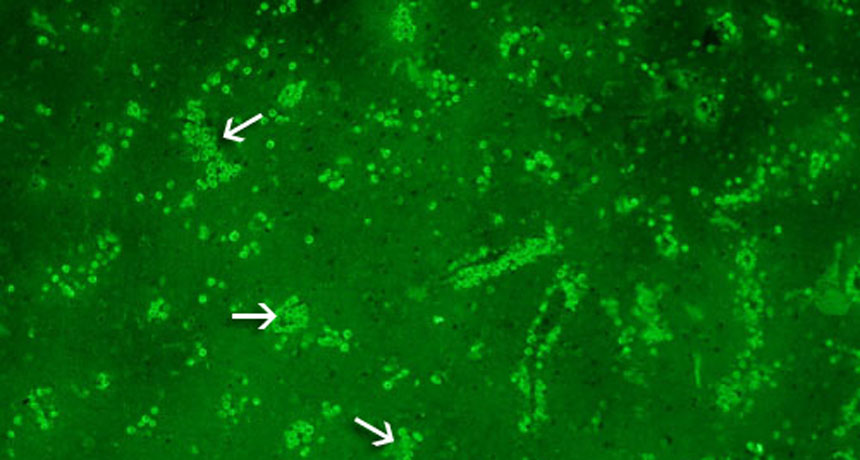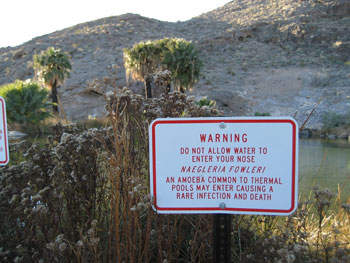Five things to know about ‘brain-eating’ amoebas
The microbes aren’t rare, but here’s why dangerous infections from them are

This section of brain came from a patient infected with N. fowleri. A fluorescent stain highlights, under the microscope, the tiny amoebas as bright green dots. Arrows point to some large clusters of them.
CDC
By Janet Raloff
In 2003, two young brothers in Arizona died suddenly of a disease that had inflamed their brains. Researchers at Virginia Commonwealth University’s Medical College, in Richmond, looked into the case. They concluded that the water supply at the boys’ home was responsible. That water hosted a deadly species of amoeba, Francine Marciano-Cabral and her team found. And the boys were easily exposed to the deadly parasite. “We suspect they got it from submerging in the bathtub,” Marciano-Cabral said.
Parasitic amoebas are blob-shaped, one-celled organisms. They can inhabit waters around the world. Scientists suspect a species called Naegleria fowleri (Neg-LAIR-ee-ah FOW-ler-eye) killed the Arizona boys. These amoebas turned up in tests of the home’s water. This water supply had not been chlorinated. That treatment can kill many amoebas and other microbes that may be in water.
People tend to be unaware of the presence of amoebas in water. Here are five things to know about N. fowleri and the risks amoebas pose. Being informed may limit your risk from these parasites.
1) N. fowleri can be found throughout the world and in a range of environments. Because these parasites like warm freshwater, they more commonly inhabit rivers and lakes in hot climates. They also can be found in some hot springs. (These waters are warmed by geothermal energy. That heat is given off by magma — liquid rock — below Earth’s surface.) But avoiding these sites will not eliminate all risk. Some people have become infected while playing in a wading pool at a home or in mud puddles after a heavy rainstorm.

3) Because the route to infection is through the nose, a clip that keeps the nose pinched closed should limit infection. Any water that will be deliberately run through the nose (or that may be used for submerging the head, as in some religious practices) should first be boiled. Boiling should last at least 1 minute at sea level and up to 3 minutes at higher elevations (especially those above 2 kilometers — roughly 6,500 feet). Potentially infected water also can be run water through a filter with a pore size of 1 micrometer or smaller.
4) Signs of infection start with headache, fever, nausea and sometimes vomiting. These symptoms may show up as early as one day after exposure. More commonly, they emerge after about 5 to 12 days. Because the brain is affected, later symptoms can progress to include neck stiffness, confusion or hallucinations, loss of balance and seizures.
5) Infections, though very serious, remain rare. Health officials know of only 35 people between 2005 and 2014 in the United States who became infected. The bad news: All but two of these people died from what is known as PAM. That acronym stands for primary amebic meningoencephalitis (Ah-MEE-bic Meh-NIN-joh-en-SEF-uh-LY-tis). The name reflects the cause of the disease’s lethality — encephalitis, or brain inflammation. But reducing inflammation — and the swelling it causes — may save someone’s life, recent research shows. That finding was first reported in the March 2015 issue of Pediatrics. A second study, published in the August 2015 Acta Tropica, also supports that idea. So where an infection is suspected, people should seek medical help immediately. And to confirm exposure to the amoebas, it could help to bring along some water for testing by a microbiologist.
Power Words
(for more about Power Words, click here)
amoeba A single-celled microbe that catches food and moves about by extending fingerlike projections of a colorless material called protoplasm. Amoebas are either free-living in damp environments or they are parasites.
chlorinate To disinfect water using chlorine, a chemical element with the scientific symbol Cl. Many drinking water suppliers use chlorination to kill germs. Chlorine is also used to control germs in pools used for swimming.
climate The weather conditions prevailing in an area in general or over a long period.
encephalitis An inflammation of the brain, usually caused by a viral infection. The disease can impair movement, clarity of thinking and other facets of brain function. In severe cases, this condition can lead to death.
environment The sum of all of the things that exist around some organism or the process and the condition those things create for that organism or process. Environment may refer to the weather and ecosystem in which some animal lives, or, perhaps, the temperature, humidity and placement of components in some electronics system or product.
geothermal energy The internal heat of the Earth or other planet.
immune system The collection of cells and their responses that help the body fight off infections and deal with foreign substances that may provoke allergies.
infection A disease that can spread from one organism to another.
inflammation The body’s response to cellular injury and obesity; it often involves swelling, redness, heat and pain. It is also an underlying feature responsible for the development and aggravation of many diseases, especially heart disease and diabetes.
magma The molten rock that resides under Earth’s crust. When it erupts from a volcano, this material is referred to as lava.
microbe Short formicroorganism, a living thing that is too small to see with the unaided eye, including bacteria, some fungi and many other organisms such as amoebas. Most consist of a single cell. (see microorganism)
microbiology The study of microorganisms, principally bacteria, fungi and viruses. Scientists who study microbes and the infections they can cause or ways that they can interact with their environment are known as microbiologists.
Naegleria fowleri A single-celled freshwater parasite, sometimes called the “brain-eating amoeba.” It lives in hot springs and other surface waters that get very warm.
nasal Having to do with the nose.
organism Any living thing, from elephants and plants to bacteria and other types of single-celled life.
parasite An organism that gets benefits from another species, called a host, but doesn’t provide it any benefits. Classic examples of parasites include ticks, fleas and tapeworms.
seizure A sudden surge of electrical activity within the brain. Seizures are often a symptom of epilepsy and may cause dramatic spasming of muscles.
species A group of similar organisms capable of producing offspring that can survive and reproduce.







